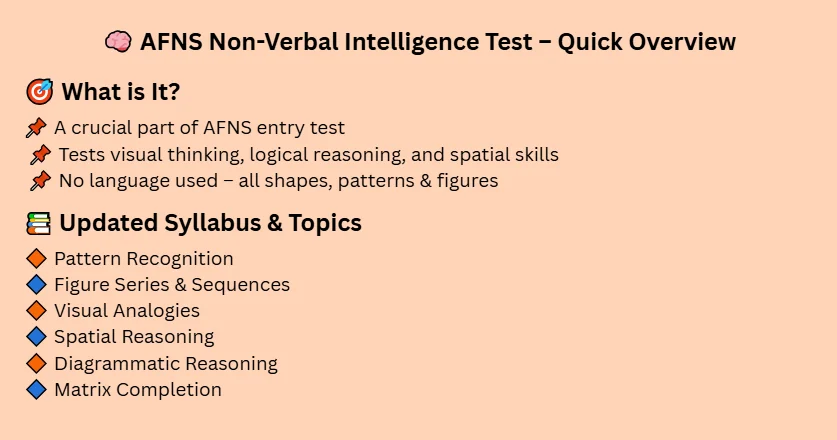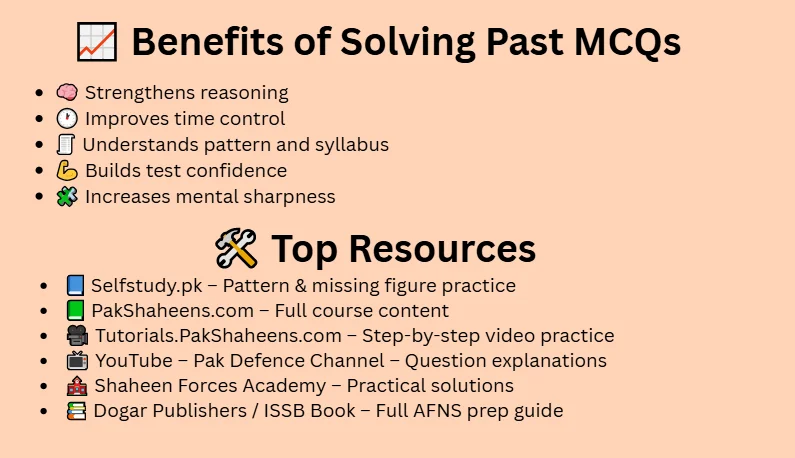The Non-Verbal Intelligence Test is a crucial stage for the Armed Forces Nursing Services (AFNS) that assesses the candidate’s visual thinking and analytical skills. Non-Verbal Reasoning test for the AFNS includes questions that include pattern recognition, sequencing, and similarity of different shapes, which test the mental abilities without using any language. The test also includes elements such as abstract thinking and spatial understanding, which reveal the candidate’s problem-solving ability.
Biology Practice Test 2
To succeed in the Non-Verbal Intelligence test for the Armed Forces Nursing Test, the candidates must practice and improve these skills so that they can prove their worth in the military services. This test not only tests mental agility but also highlights critical thinking and analytical abilities, which are essential for a successful nursing officer.
The Non-Verbal Intelligence Test section of AFNS under the Pakistan Army is a very important part of the initial stage. This test tests the mental ability, problem-solving skills, and intelligence level of the female candidate. Such tests typically involve abstract thinking, pattern recognition, and visual-spatial skills, which are considered core components of logical thinking.
Top Resources to Prepare for AFNS Non-Verbal Intelligence Test
Non-Verbal Intelligence Test for the AFNS PDF
The “Non-Verbal Intelligence Test for the AFNS PDF” available for download is a great choice in this regard as this PDF file has been specially prepared for the AFNS exam and covers all the important aspects of non-verbal intelligence. It includes sections on various patterns, relationships between shapes, and visual logic that enhance your practice. Moreover, this PDF also provides solved examples and practice questions that help you understand the questions and solve them effectively.
Non-Verbal Intelligence Test for the AFNS PDF resources enable you to better manage your time in the exam, allowing you to solve even difficult questions in less time. If you practice regularly with the help of this PDF, you will be able to perform well in the non-verbal intelligence test and increase your chances of success in the AFNS exam.
Non-verbal Intelligence Test PDF with Answers
The “Non-verbal Intelligence Test PDF with Answers” is an unparalleled guide for the AFNS initial test. The Non-Verbal Intelligence test PDF file is specifically designed for the AFNS exam, covering all the essential aspects, including visual reasoning, shape continuity, pattern recognition, and logical sequencing.
The special thing about this PDF is that it not only contains questions but also detailed answers and solution methods for each question, which help students learn from their mistakes and improve their visual problem-solving skills. Being in PDF format, you can use it anytime and anywhere on your mobile, tablet, or laptop, which makes your preparation process more flexible and effective.
Non-Verbal Intelligence Test MCQs
“Non-Verbal Intelligence Test MCQs” is a very useful and effective tool for the preparation of the AFNS Non-Verbal Intelligence Test, which provides all the necessary skills required by students to succeed in the exam. These MCQs have been specially designed keeping in mind the AFNS exam pattern, which includes important topics like visual reasoning, shape continuity, pattern completion, and logical order.
With the help of these questions, you can not only improve your visual intelligence but also get familiar with the types of possible questions that may appear in the exam. The detailed solutions and explanatory answers provided with each question provide you with a rich opportunity to review your performance and address weaknesses.
Non-Verbal Intelligence Test online
Online nonverbal intelligence tests include a variety of exercises such as picture puzzles, shape completion, pattern recognition, and understanding logical sequences, which are directly helpful in the AFNS exam.
Such online platforms provide exercises from difficult to easy levels over time, which improves the candidate’s observational skills and quick thinking habits. Moreover, these online tests often have a timer, which creates a pressure similar to the real exam environment, so that candidates can practice solving questions under time constraints.
- Selfstudy.pk – This website provides free picture exercises, picture matching, pattern matching, and missing figure identification questions, along with time constraints to create a real exam-like environment.
- PakShaheens.com – It offers complete AFNS-specific test courses on topics such as diagrammatic reasoning, visual analysis, and spatial arrangement, which help in preparing for frequently asked questions.
- Tutorials.PakShaheens.com – This platform provides practice in spatial perception, picture sequences, and pattern completion through video lectures, which are easy to understand from the very beginning to the advanced level.
- YouTube Channels- Pak Defence Channel – This channel teaches AFNS test-related exercises, sample questions, and their answers in detail.
- Shaheen Forces Academy – It offers a complete lecture series and practical explanations of question solutions, which improve mental analogy and sequential development.
- Books & PDFs- ISSB Non-Verbal Intelligence Book – This book contains popular questions, visual sequences, and pattern recognition, which is especially useful for AFNS aspirants.
- Dogar Publishers AFNS Guide- It has complete test patterns, exercises, and past questions that provide complete guidance.

AFNS Non-Verbal Test Syllabus & Topics
The AFNS Non-Verbal Intelligence test syllabus mainly consists of spatial reasoning, pattern recognition, and abstract thinking. It includes questions asking candidates to recognize visual patterns, perform diagrammatic analysis, and select appropriate forms of blanks using matrices. All these activities test the candidate’s problem-solving ability and mental stability without using language, which is very important for admission to AFNS.
Pattern Recognition
Pattern recognition is a fundamental mental process in the human mind through which we recognize the visual order hidden in the information received from the surrounding environment. This process not only helps us understand everyday things in an organized manner but also provides us with the ability to discover new patterns or trends through inductive reasoning.
When we select the next item or new shape in a sequence, our brain automatically infers the complete picture hidden in the order through observational ability. This skill of pattern recognition is of great importance not only in ordinary life but also in educational and professional tests such as AFNS
Figure Series and Sequences
Figure Series and Pattern Progression play a very important role in non-verbal intelligence tests like AFNS. In these exercises, candidates have to observe the sequential development of shapes, so that they can identify the next or missing figure based on the diagrammatic reasoning hidden in the above sequence.
In this process, the candidate has to understand the principles hidden in the visual sequence using spatial visualization, and then determine the correct answer through sequence completion. All these aspects are interconnected and test the candidate’s mental capacity to the fullest.
These picture series exercises teach the brain the principles of systematic thinking and make its understanding of sequential progression effective in future advanced situations.
Visual Analogies
In Visual Analogies, the candidate has to find the ideal nature in different shapes or diagrams by understanding the relationship between them. This process creates pattern matching in their mind, where they apply the principle of one shape to another to identify the missing or different item. The main objective of this exercise is to understand the similarities hidden in complex diagrams through mental analogy and make logical choices.
These are analogous to drawing diagrams or diagrammatic analysis, which test the candidate’s non-verbal thinking and mental analogy skills. Such questions test the ability to recognize the hidden structure in the layout of the brain and complete it logically, which is very important for measuring non-verbal intelligence in tests like AFNS
Spatial Reasoning
Spatial perception is a key element in non-verbal intelligence tests, where the candidate is required to recognize different shapes and mentally understand their visual arrangement. This involves seeing relationships within two or three-dimensional objects through mental imagery, and placing shapes in the correct order by rotating or flipping them through mental rotation. These types of exercises strengthen the sequential logic of the brain, so that when faced with difficulties, the candidate can systematically analyze visual references to find solutions.
Diagrammatic Reasoning
Diagrammatic Reasoning is a mental process in which the candidate has to analyze different forms and discover the logical order in them. In this, he has to understand the practical rules, that is, the principles that are hidden in the changes of each form or diagram.
When the candidate is given a sequence in a diagram, he has to find out based on visual rules, what the next form will be or what will fill the empty box, so that he can choose the answer by completing the sequence and then finding the solution.

Effective Preparation Strategies for AFNS Non-Verbal Reasoning Test
- Understanding the Syllabus – First, learn what topics are covered in the test, such as image sequencing, diagram analysis, and pattern recognition.
- Sample Practice – Solve image and non-verbal exercises daily to develop an understanding of the types and structure of questions.
- Time Management – Practice solving questions in a limited time so that you don’t run out of time on the actual test.
- Observational Strategies – Look at each question carefully, learn to quickly notice similarities and differences in shapes.
- Practice Continuity – Practice regularly every day to continuously improve your mental analysis and non-verbal skills.
AFNS Non-Verbal MCQs Weightage and Scoring Breakdown
The AFNS Non-Verbal Intelligence test is about 50-60 questions with a time frame of 30 minutes to complete. According to the interpretive distribution of this test, a candidate has to score at least 50% of the marks to pass in order for his/her performance to be measured accurately. Such a strict standard provides a good indication of the seriousness of the test and the mental capacity of the candidate.
These 64 questions often involve non-verbal representations, such as pictorial patterns, diagrammatic reasoning, spatial sequences, or pattern sequences, which measure the analytical and visual thinking ability of the AFNS candidate.
Top Mistakes to Avoid in the AFNS Non-Verbal Intelligence Test
- Rushing to decide – Many candidates choose answers in a short period of time, which affects accuracy.
- Lack of time management – Not using time effectively to solve questions can affect overall performance.
- Not reading questions carefully – Answering without understanding the main idea or pattern of the question is a common mistake.
- Lack of attention– Not paying enough attention to small details, especially the order or small differences, leads to mistakes.
- Mistakes under pressure – Not being able to relax under the pressure of the real test and making hasty choices can hurt the results.
Benefits of Solving Past MCQs for AFNS Non-Verbal Reasoning Test
- Past MCQs help in following the syllabus and understanding important topics
- These questions provide an opportunity to understand the test pattern and test its structure
- Practice with different question types increases mental capacity
- Gets excellent time management skills to control time
- Constant practice increases confidence and strengthens logical reasoning
FAQs
What is the Nonverbal Intelligence Test in AFNS?
It is a visual reasoning test that assesses your ability to recognize patterns and solve problems without using language.
How to prepare for the AFNS Nonverbal Test?
Practice past MCQs regularly, focus on pattern recognition, and improve your visual problem-solving skills.
